#blaberidae
Text

Ball Cockroaches (Perisphaerus spp.), family Blaberidae, Singapore
photograph by Melvin Yeo
4K notes
·
View notes
Text

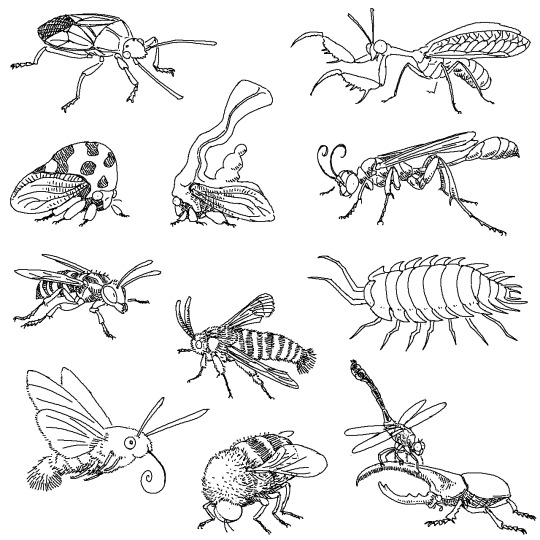
i'm thinking about bugs
#bflyart#bug doodles#commissions#reduviidae#araneidae#blaberidae#ectobiidae#carabidae#vespidae#sphecidae#pentatomidae#coriidae#plataspidae#cicadidae#caprellidae#rhopalidae#mantispidae#membracidae#sesiidae#styloniscidae#sphingidae#acroceridae#scarabaeidae#gomphidae#pay me $5 to draw you a bug
2K notes
·
View notes
Text
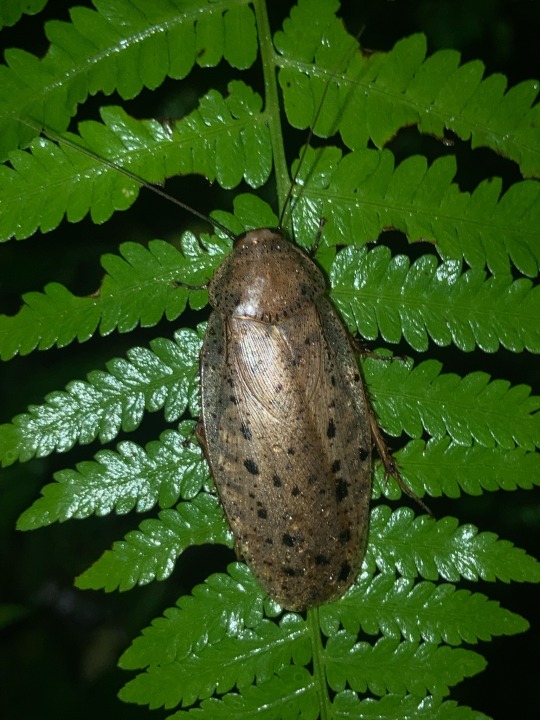
la cucuaracha epilamprina 👍
#cockroach#insecta#blattodea#blaberooidea#blaberidae#empilamprinae#probably rhabdoblatta but i honestly dont know.#never seen one this spotty
199 notes
·
View notes
Text
Uncharismatic Fact of the Day
The rhinocerus cockroach got its name for a good reason-- it's the largest species of cockroach in the world. These guys can be as long as 80 mm (3.1 in), and weigh a whopping 35 g (1.2 oz). Because of their large size, they are also one of the few species of cockroach that lack wings.
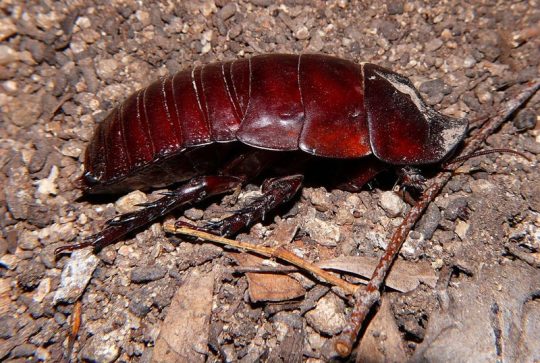
(Image: A rhinoceros cockroach (Macropanesthia rhinoceros) by Steve and Alison Pearson)
If you like what I do, consider leaving a tip or buying me a kofi!
#giant burrowing cockroach#rhinoceros cockroach#Blattodea#Blaberidae#giant cockroaches#cockroaches#insects#arthropods#uncharismatic facts
85 notes
·
View notes
Video
Absolute unit of a Madagascar hissing roach
(X) <-
#madagascar hissing cockroach#cockroach#hissing cockroach#roach#insect#insects#gromphadorhina#gromphadorhina portentosa#animal#animals#wildlife#wild animals#nature#video#animal video#animal videos#blaberidae
52 notes
·
View notes
Text
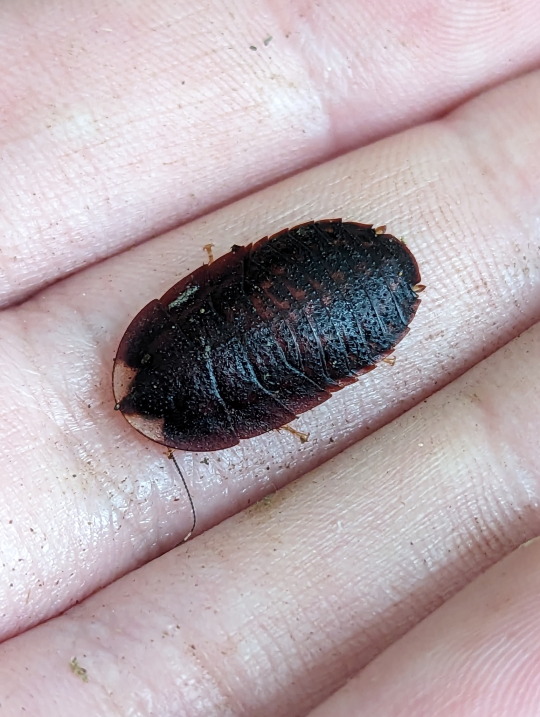

Native cockroach species.
30/09/23 - Laxta sp. - Eubenangee, swamp, under rotting wood
#invertblr#invertebrates#Arthropods#Arthropoda#bugs#bugblr#bugs tw#bug#insects#insecta#insect#insectblr#insects tw#entomology#Laxta#unidentified#Blaberidae#Giant Cockroaches#Blattodea#roaches#cockroaches
6 notes
·
View notes
Text

#cockroach#roach#blaberidae#blaberus#blaberus giganteus#cave roach#giant cave roach#brazilian cave roach#blattodea#giant roaches#october#mspaint
4 notes
·
View notes
Text
Appreciating: Blaptica dubia!

Blaptica dubia, known commonly as the Dubia cockroach, are by far my absolute favorite insect of all time. On that note, I feel like it's fitting that they are the topic of my first post like this!
These appreciation posts will tend to be quite long, so I hope you keep reading! I'm prone to rambling about invertebrates, and cockroaches even more so
Commonly kept by those who own reptiles as little more than livestock, Dubia roaches are often overlooked. While they can do fine with egg cartons, they truly thrive when given a variety of natural resources.
Dubia cockroaches can be found in the tropical rainforests Brazil, Argentina and Costa Rico. They are frugivores, and love moist and sugary fruits like mangos, watermelon and oranges. They are avid decomposers, grazing on anything from rotting leaves to fallen fruit.
I adore Blaptica dubia so much because of their laidback demeanor, clustering behavior and affinity for fresh ripe fruit. Like most cockroaches, they are sensitive to bright light and prefer a dark spot to hang out.
Dubia nymphs act very different than their parents, as do most blattodeans. While the adult roaches will happily graze on the surface, nymphs are frantic and very alert. Adults will climb around on elevated surfaces and often cluster together, while juveniles prefer to hide under any available item.
If one observes the same individuals over and over again, it's clear that they have some sort of personalities! Some adults are very brave and will always be the first to check out a new foodstuff, while others are lazy and spend their days lounging around.
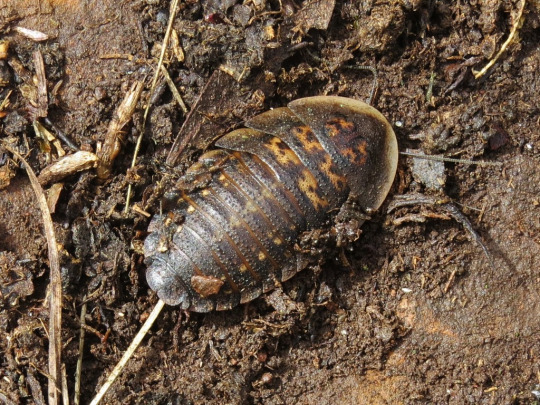
Personally, I keep a very small colony of Blaptica dubia as pets. They exhibit some very fun behaviors like food and nest preferences! My three adult Dubias like to eat papaya, mango and avocado while the countless nymphs prefer banana, sweet potato and grapes!
The adults live by themselves, alongside a few assorted isopods and a few very young juveniles, in their own vivarium. The older nymphs live in the other two tanks, digging around in the rich soil. Very young nymphs feed on their parents' frass (the arthropod equivalent of dung) in order to build a healthy gut microbiome!
Thank you for reading! I love cockroaches more than anything else on Earth, and Blaptica dubia being my favorite species! I really hope you liked this post!
#bug tw#blaptica dubia#dubia cockroaches#bug appreciation#bugblr#entomology#blattodea#blaberidae#insects
3 notes
·
View notes
Text
#1845 - Laxta rieki - Trilobite Roach

Banjup, Perth.
Males are winged with a wide thoracic shield, but the females are wingless and can cling very securely to the wood and bark they’re hiding under. The best-known species is L. granicollis, but that’s probably because all but one of the other 13 species were named and described in 1992.
1 note
·
View note
Text
My mom is trying to work at her wfh job but I'm standing next to her showing her images of beautiful cockroaches.
0 notes
Text

this mysterious object is an ootheca, a cockroach egg case, but this one is special:
while females of many roaches, including household species, will run around with hard-skinned oothecae extruded before dumping them somewhere safe, cockroaches in the family Blaberidae extrude then withdraw a soft, membranous ootheca into their bodies again until the eggs are ready to hatch—they’re livebearing! it isn’t a true uterus, but the brood pouches of some blaberids supply the developing eggs with essential moisture.
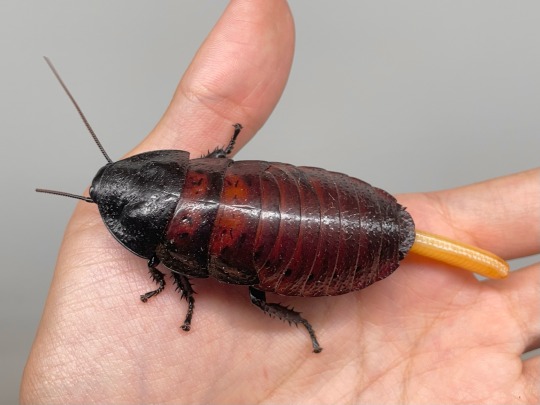
this ootheca belongs to a hybrid stock Madagascan hissing cockroach (Gromphadorhina portentosa x hybrid). roaches of this genus may produce a nutritious fluid from the brood sac which supplies the babies with a good meal before they part ways with their mother.
read about ovoviviparity in cockroaches here:
307 notes
·
View notes
Text

rotating my sleek metal briefcase around on the table to face you, i click it open to reveal an assortment of bugs
#bug doodles#Reduviidae#Caprellidae#Ectobiidae#Blaberidae#Styloniscidae#Cicadidae#reminder i will draw any bug for you in this style for $5 usd#also roaches are surprisingly hard to get right it turns out
1K notes
·
View notes
Text
benefits of keeping members of blaberidae: having an excuse to say "ovoviviparous" with some regularity
#one of my favorite words. up there with zygodactyly and leptocephalus but is easily the most fun to say.#anyway i'm on the lookout for a certain species
0 notes
Photo
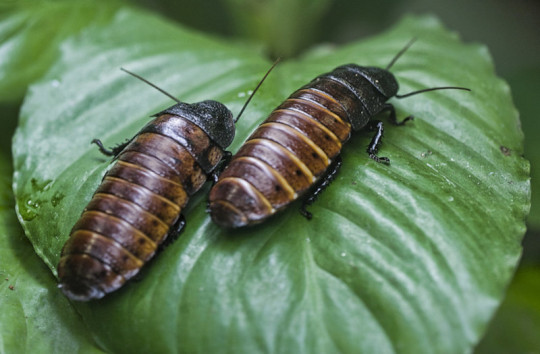

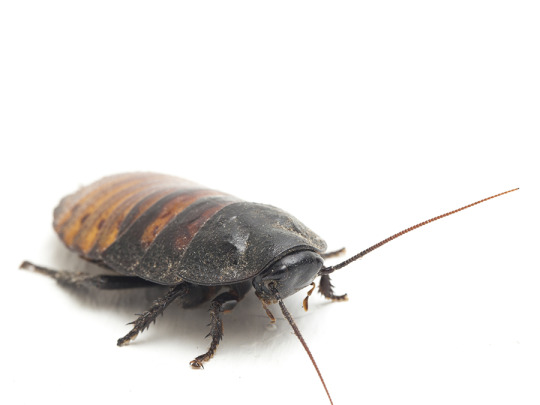
Cozy Up to the Madagascar Hissing Cockroach
One of twenty hissing cockroach species, the Madagascar hissing cockroach or simply the hisser (Gromphadorhina portentosa) is found only on the island of Madagascar. There, it prefers the dry leaf litter and rotting logs of lowland tropical rainforests, though it can also be found in cool, damp, dark areas of buildings. These habitats are ideal as they can offer both refuge from predators like rodents and birds, and food: hissing cockroaches are detritovores, feeding exclusively on decaying plant and animal matter. This makes them important members of the ecosystem as they recycle nutrients back into the soil.
G. portentosa is one of the largest species of cockroach in the world, reaching up to 7 cm (3 in) and 24 g (0.8 oz) when fully grown. Unlike other cockroaches, the hisser lacks wings and travels exclusively over the ground. Fortunately their hard, dark brown exoskeleton provides excellent camoflage against the forest floor. Males and females are nearly identical; the only difference is the pair of horns, or pronatal humps, found just behind the male’s head.
Though they may live in close quarters, madagascar hissing cockroaches are largely individualistic. Males fiercely guard small territories, only leaving occasionally to find food and water. Females and young are somewhat more social, and move in and out of these territories freely. As their name implies, hissers communicate primarily by hissing. This sound is produced by expelling air through their bodies. Four distinct hisses have been identified, each with different meanings; territorial displays, mating calls, and an alarm hiss to warn away predators.
Hissers reproduce all year round, provided the weather is warm enough. Males attract females by hissing loudly, and fight off rival males through hissing competitions and posturing. When a female enters a male’s territory, she emits a chemical to attract a mate. When the pair meet, they enter a brief courtship ritual involving vocalizations and touching each other’s antennae; they then position themselves end to end and remain there for upwards of 30 minutes.
The female will carry her fertilized egg case, or ootheca, for about two months. Up to 40 nymphs will hatch from the case while still inside their mother, who then expells her young all at once. These nymphs resemble adults in structure, but are smaller and lack reproductive organs. Initially they are white, but quickly turn brown or black as they grow, molting about once a month until fully grown. Sexual maturity is reached at about seven months of age, but individuals can live for up to 5 years.
Conservation status: The Madagascar hissing cockroach has not been evaluated by the IUCN, and populations are considered to be stable. In addition, many zoos and private collectors maintain hissing cockroaches for display or food for other animals, as the species is low maintenence and easy to breed in captivity.
If you like what I do, consider leaving a tip or buying me a ko-fi!
Photos
Liz West
Lincoln Park Zoo
Alexandria Zoo
#madagascar hissing cockroach#Blattodea#Blaberidae#hissing cockroaches#cockroaches#insects#arthropods#tropical forests#tropical forest arthropods#tropical rainforests#tropical rainforest arthropods#africa#madagascar#biology#zoology#animal facts
181 notes
·
View notes
Text
Cucaracha Gigante de Madagascar 4-8cm
La cucaracha gigante de Madagascar o cucaracha silbadora es una especie de insecto blatodeo de la familia Blaberidae. Es una de las mayores cucarachas, alcanzando una longitud de 5 a 8 cm en la madurez. Proceden de la isla de Madagascar, frente a la costa africana, donde pueden encontrarse en troncos putrefacto.
Las cucarachas gigantes de Madagascar también se usan como mascotas. Carecen de alas…
View On WordPress
0 notes
Link
0 notes